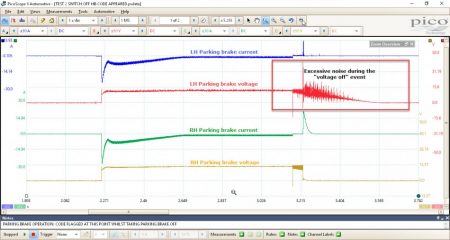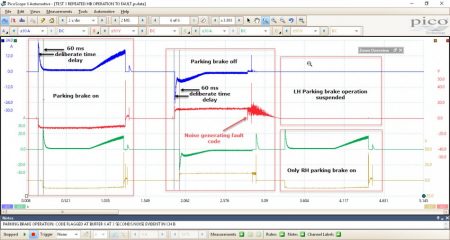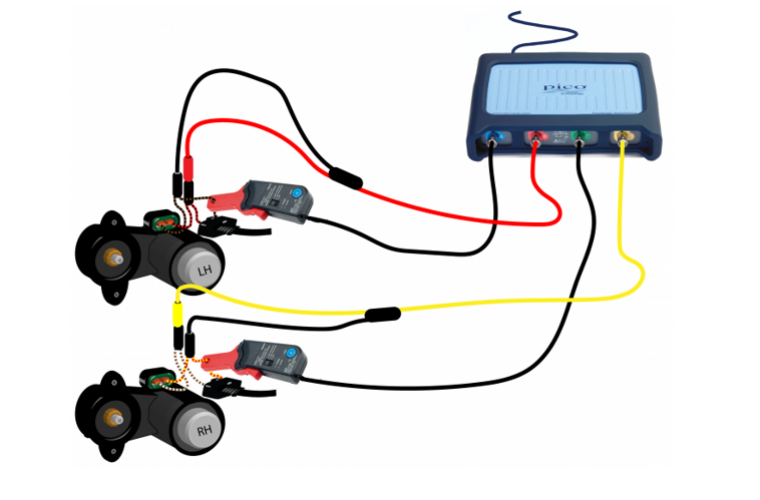Pico Automotive has published its diagnostic process when presented with a 2013 Audi A6 Quattro S-Line with an electronic parking brake failure.
Job sheet
Customer reports the following messages appear within the instrument panel:
- Parking brake malfunction
- Start/Stop system deactivated
Fault codes:
- ENGINE- 17403 – implausible data received from parking brake control module U0417 00
- ABS- 0486 – Function restriction due to faults in other modules U1113 00
- ABS- 0692 – Function restriction due to faults in other modules U1113 00
- EPB- 67840 – Left parking brake motor voltage supply C100D 01 [008] – electrical failure
- EPB- 71424 – Left parking brake motor voltage supply C100D 12 [008] – short to plus
Further questioning of the customer revealed the electronic parking brake (EPB) occasionally failed to release after standing overnight with the EPB applied.
When the fault occurs, the vehicle can be driven without any brake binding or drag, suggesting the parking brake has released.
The symptom had been very intermittent for over 12 months regardless of temperature or driving conditions.
Additional feedback from the customer added, if the ignition was turned off and back on, the error messages cleared and the parking brake performed normally.
However, occasionally the ignition was required to be turned off for over 20 minutes before the parking brake function was restored.
During the road test it became apparent that the left-hand rear calliper parking brake mechanism appeared to lag behind the right-hand rear calliper when listening to their operation.
During this stress test a chime was emitted from the instrument panel and the parking brake malfunction message appeared.
With the error message displayed, further switching of the parking brake confirmed no operation of the LH parking brake actuator whereas the RH functioned normally.
Cycling the ignition restored both parking brake actuators to normal operation.
Diagnosis
The customer interview highlighted a full-service history, numerous accessories installed, and the recent replacement of the LH parking brake actuator but not the complete calliper assembly.
An initial inspection confirmed correct installation of a new LH rear parking brake actuator, the rear brake linings to be serviceable whilst freely operating, and all visible electrical connections and harness routing under the vehicle to both rear brake calliper to be secure.
Based on the evidence acquired so far, pursuing the parking brake fault codes became the priority.
Before going any further, Pico Automotive advises technicians to check its technical bulletins, software updates, recalls and campaigns.
For this particular case, this action revealed that a number of parking brake control units were utilised for these vehicles, each of which could be identified by their part number suffix.
For example, parking brake control unit part number 4H0 907 801 may contain the suffix F, G, or H.
Replacement control units should contain the suffix L, however it was not clear if control units with the earlier suffix F, G, and H were carrying known concerns.
All we know at this stage is that a replacement parking brake control unit should contain an L suffix or later.
The vehicle scan identified the control unit as 4H0 907 801 G.
Food for thought during the diagnosis but insufficient data to warrant replacement control unit without proof of failure.
Reproducing the fault
After saving and erasing all the above fault codes, the parking brake was once again stress tested by repeatedly operating the park brake whilst monitoring live data.
Initially both actuators functioned correctly drawing approx. 17.5 A until the parking brake malfunction error message appeared.
This occurred when releasing the parking brake, not applying.
With the fault now present, continual operation of the parking brake confirmed no current flow to the LH parking brake actuator, RH operation was normal.
A brief check of the fresh fault codes confirmed the return of EPB- 67840 (Left parking brake motor voltage supply C100D 01 [008] – electrical failure) and EPB- 71424 (Left parking brake motor voltage supply C100D 12 [008] – short to plus).
The PCM and ABS modules also reported U codes, indicating communication errors with the EPB module.
At this stage we can attribute these codes to missing messages from the EPB module as the parking brake malfunction results in communication anomalies generating multiple warnings for the driver.
Possible causes include left-hand parking brake circuit integrity, left-hand parking brake actuator malfunction or
EPB control module malfunction.
Diagnosis
 The action plan is predominately governed by accessibility and probability.
The action plan is predominately governed by accessibility and probability.
Based on the fact the left-hand parking brake actuator is repeatedly indicated as the offender, we need to qualify the actuator circuit.
With the fault present on the vehicle, the current flow and voltage supply to both right and left-hand parking brake actuators was captured using breakout leads and two current clamps connected to PicoScope.
PicoScope live data confirmed there was no voltage supply or current flow to the left-hand parking brake actuator.
However peak inrush current to the RH actuator exceeds 20 A.
Using the PicoScope 4425 model with floating inputs we have the advantage of measuring across the brake actuator Channel B red and D yellow to confirm the presence of both power and ground simultaneously during actuator operation.
Given the fault was becoming easier to reproduce, the fault codes were once again erased and the parking brake operated whilst monitoring voltage and current to both actuators.
The theory here was to catch the exact moment the fault appeared and identify what events were taking place in the parking brake circuit.
 We captured one of those rare intermittent glitches which is directly responsible for our EPB fault codes.
We captured one of those rare intermittent glitches which is directly responsible for our EPB fault codes.
Closer analysis reveals a number of concerns with the voltage supply and current flow through the LH parking brake actuator.
Looking at the zoomed waveform we could clearly see excessive noise 41 V peak about the supply voltage to the left-hand parking brake actuator Channel B red.
The effect of such noise results in sporadic induced current flow, a 14 A peak at the point of power off to the left-hand parking brake actuator during the release function.
If we compare Channel B red to Channel D yellow, notice how the voltage supply 12.9 V peak instantaneously drops to near zero volts at the point of power off, Channel D yellow, after the parking brake mechanism has released its grip on the brake pads.
 Here the induced current flow at 3.22 s, 20 A peak for the RH parking brake actuator Channel C green has a rapid increase and controlled decay compared to the LH actuator Channel A blue.
Here the induced current flow at 3.22 s, 20 A peak for the RH parking brake actuator Channel C green has a rapid increase and controlled decay compared to the LH actuator Channel A blue.
Whilst the formation and decay of this current is a clue to the parking failure, it is most certainly a symptom and not a cause.
Our parking brake control module suggests the left-hand parking brake actuator has a short to battery positive.
This can be seen in the time taken for the voltage on Channel B red to fall to zero volts after the parking brake release function has completed.
The left-hand actuator voltage decay time measures approx. 350 ms compared to the RH actuator at approx. 15 ms, therefore interpreted as fault code 71424 – left parking brake motor voltage supply – short to plus.
Summary of diagnosis
Only during the release function of the parking brake do we see intermittent excessive noise which generates a fault code within the EPB system referring to the LH parking brake actuator.
The application of the parking brake does not generate noise or induce a fault code.
The LH parking brake actuator has been replaced. Had the actuator been responsible for the noise e.g. arcing motor brushes, the noise would have been present during parking brake on and off.
The circuit between the EPB module and LH actuator is good based on the values compared at both the module and actuator.
The power and ground to the EPB module are good with zero noise on the power supply to the control unit when the fault occurs.
Based on the summary above the EPB control module was replaced as the source of our noise during the parking brake release function.
With the EPB module replaced using a device containing the correct suffix, part number 4H0 907 801 L, stress testing was once again carried out to confirm a fix.
For further information, follow the ‘more details’ link below.







